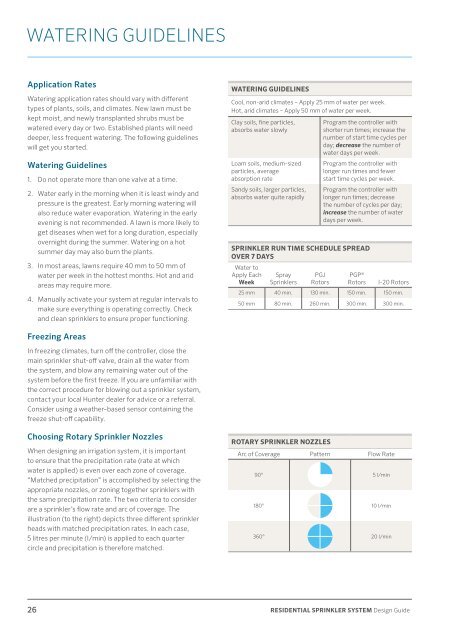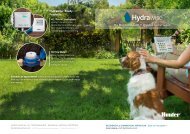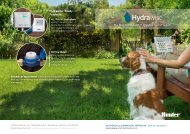Hunter Residential Sprinkler System / Irrigation system design guide - Calgary irrigation
Residential Irrigation Service and Design Guide for underground sprinklers. Learn how to design, install, service, repair and winterize your underground sprinkler system. Irrigation Calgary. Lawn irrigation. Underground sprinklers Calgary
Residential Irrigation Service and Design Guide for underground sprinklers. Learn how to design, install, service, repair and winterize your underground sprinkler system. Irrigation Calgary. Lawn irrigation. Underground sprinklers Calgary
Create successful ePaper yourself
Turn your PDF publications into a flip-book with our unique Google optimized e-Paper software.
WATERING GUIDELINES<br />
Application Rates<br />
Watering application rates should vary with different<br />
types of plants, soils, and climates. New lawn must be<br />
kept moist, and newly transplanted shrubs must be<br />
watered every day or two. Established plants will need<br />
deeper, less frequent watering. The following <strong>guide</strong>lines<br />
will get you started.<br />
Watering Guidelines<br />
1. Do not operate more than one valve at a time.<br />
2. Water early in the morning when it is least windy and<br />
pressure is the greatest. Early morning watering will<br />
also reduce water evaporation. Watering in the early<br />
evening is not recommended. A lawn is more likely to<br />
get diseases when wet for a long duration, especially<br />
overnight during the summer. Watering on a hot<br />
summer day may also burn the plants.<br />
3. In most areas, lawns require 40 mm to 50 mm of<br />
water per week in the hottest months. Hot and arid<br />
areas may require more.<br />
4. Manually activate your <strong>system</strong> at regular intervals to<br />
make sure everything is operating correctly. Check<br />
and clean sprinklers to ensure proper functioning.<br />
WATERING GUIDELINES<br />
Cool, non-arid climates – Apply 25 mm of water per week.<br />
Hot, arid climates – Apply 50 mm of water per week.<br />
Clay soils, fine particles,<br />
absorbs water slowly<br />
Loam soils, medium-sized<br />
particles, average<br />
absorption rate<br />
Sandy soils, larger particles,<br />
absorbs water quite rapidly<br />
Program the controller with<br />
shorter run times; increase the<br />
number of start time cycles per<br />
day; decrease the number of<br />
water days per week.<br />
Program the controller with<br />
longer run times and fewer<br />
start time cycles per week.<br />
Program the controller with<br />
longer run times; decrease<br />
the number of cycles per day;<br />
increase the number of water<br />
days per week.<br />
SPRINKLER RUN TIME SCHEDULE SPREAD<br />
OVER 7 DAYS<br />
Water to<br />
Apply Each<br />
Week<br />
Spray<br />
<strong>Sprinkler</strong>s<br />
PGJ<br />
Rotors<br />
PGP ®<br />
Rotors<br />
I-20 Rotors<br />
25 mm 40 min. 130 min. 150 min. 150 min.<br />
50 mm 80 min. 260 min. 300 min. 300 min.<br />
Freezing Areas<br />
In freezing climates, turn off the controller, close the<br />
main sprinkler shut-off valve, drain all the water from<br />
the <strong>system</strong>, and blow any remaining water out of the<br />
<strong>system</strong> before the first freeze. If you are unfamiliar with<br />
the correct procedure for blowing out a sprinkler <strong>system</strong>,<br />
contact your local <strong>Hunter</strong> dealer for advice or a referral.<br />
Consider using a weather–based sensor containing the<br />
freeze shut-off capability.<br />
Choosing Rotary <strong>Sprinkler</strong> Nozzles<br />
When <strong>design</strong>ing an <strong>irrigation</strong> <strong>system</strong>, it is important<br />
to ensure that the precipitation rate (rate at which<br />
water is applied) is even over each zone of coverage.<br />
“Matched precipitation” is accomplished by selecting the<br />
appropriate nozzles, or zoning together sprinklers with<br />
the same precipitation rate. The two criteria to consider<br />
are a sprinkler’s flow rate and arc of coverage. The<br />
illustration (to the right) depicts three different sprinkler<br />
heads with matched precipitation rates. In each case,<br />
5 litres per minute (l/min) is applied to each quarter<br />
circle and precipitation is therefore matched.<br />
ROTARY SPRINKLER NOZZLES<br />
Arc of Coverage Pattern Flow Rate<br />
90° 5 l/min<br />
180° 10 l/min<br />
360° 20 l/min<br />
26 RESIDENTIAL SPRINKLER SYSTEM Design Guide





